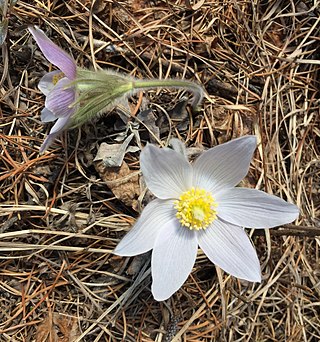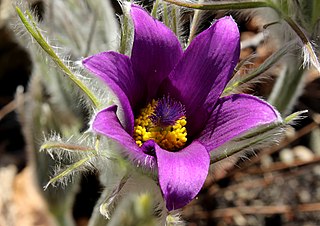
The genus Pulsatilla contains about 40 species of herbaceous perennial plants native to meadows and prairies of North America, Europe, and Asia. Common names include pasque flower, wind flower, prairie crocus, Easter flower, and meadow anemone. Several species are valued ornamentals because of their finely-dissected leaves, solitary bell-shaped flowers, and plumed seed heads. The showy part of the flower consists of sepals, not petals.

Alexander Georg von Bunge was a Russian botanist. He is best remembered for scientific expeditions into Asia and especially Siberia.

Pinus gerardiana, commonly known as the chilghoza pine or neja, is a pine species native to parts of central and southern Asia, including the western Himalayas. The International Union for Conservation of Nature (IUCN) listed it as near threatened in 2011. The pine nuts are locally collected for consumption.

Pinus bungeana, also known by the common names Bunge's pine, lacebark pine and white-barked pine, is a pine tree native to northeastern and central China. It is a slow-growing tree that can grow to heights of 15–25 metres (49–82 ft) is frost hardy down to below −26 °C (−15 °F). Its smooth, grey-green bark gradually sheds in round scales to reveal patches of pale yellow, which turn olive-brown, red and purple on exposure to light.

Pulsatilla vulgaris, the pasqueflower, is a species of flowering plant belonging to the buttercup family (Ranunculaceae), found locally on calcareous grassland in Europe, and widely cultivated in gardens. It was considered part of the genus Anemone, to which it is closely related. Several sources still list Anemone pulsatilla as the accepted name, with Pulsatilla vulgaris as a synonym.

Pulsatilla alpina, the alpine pasqueflower or alpine anemone, is a species of flowering plant in the family Ranunculaceae, native to the mountain ranges of central and southern Europe, from central Spain to Croatia. It is an herbaceous perennial growing to 15–30 cm (6–12 in) tall by 20 cm (8 in) wide, and can be found at altitudes of 1,200–2,700 m (3,900–8,900 ft).

Pulsatilla vernalis is a species of flowering plant in the family Ranunculaceae, native to mountainous habitats in Europe. Growing to 10 cm (4 in) high and wide, it is a semi-evergreen perennial with hairy, divided leaves. In early spring it bears anemone-like flowers which are up to 6 cm (2 in) in diameter, white flushed with violet on the outer surface of the petals, and prominent yellow stamens.

Pulsatilla pratensis, the small pasque flower, is a species of flowering plant in the family Ranunculaceae, native to central and eastern Europe, from southeast Norway and western Denmark south and east to Bulgaria. It grows from near sea level in the north of the range, up to 2,100 m (6,900 ft) in the south of its range.

Anemonastrum canadense, synonym Anemone canadensis, the Canada anemone, round-headed anemone, round-leaf thimbleweed, meadow anemone, windflower, or crowfoot, is a herbaceous perennial flowering plant in the family Ranunculaceae. It is native to moist meadows, thickets, streambanks, and lakeshores in North America, spreading rapidly by underground rhizomes. It is valued for its white flowers.

Pulsatilla occidentalis, synonym Anemone occidentalis, the white pasqueflower or western pasqueflower, is a herbaceous species of flowering plant in the buttercup family Ranunculaceae. Individuals are 10–60 cm (3.9–23.6 in) tall, from caudices, with three to six leaves at the base of the plant that are 3-foliolate, each leaflet pinnatifid to dissected in shape. Leaf petioles are 6–10 cm (2.4–3.9 in) long. Leaves have villous hairs and their margins are pinnatifid or dissected. Plants flower briefly mid-spring to mid-summer, usually soon after the ground is exposed by melting snow. The flowers are composed of five to seven sepals, normally white or soft purple, also mixed white and blueish purple, one flower per stem. The sepals are 15–30 mm (0.59–1.18 in) long and 10–17 mm (0.39–0.67 in) wide. Flowers have 150–200 stamens. The fruit occurs in heads rounded to subcylindric in shape, with pedicels 15–20 cm (5.9–7.9 in) long. The achenes are ellipsoid in shape, not winged, covered with villous hairs, with beaks curved that reflex as they age and 20–40 mm (0.79–1.57 in) long, feather-like. Generally, the fruit persists into fall.

Pulsatilla patens is a species of flowering plant in the family Ranunculaceae, native to Europe, Russia, Mongolia, and China. Common names include Eastern pasqueflower and cutleaf anemone.
Pulsatilla chinensis is a species of plant in the family Ranunculaceae and is one of the 50 fundamental herbs used in traditional Chinese medicine. There it has the name bái tóu wēng.

Pulsatilla nuttalliana, known as American pasqueflower, prairie pasqueflower, prairie crocus, or simply pasqueflower, is a flowering plant native to much of North America, from the western side of Lake Michigan, to northern Canada in the Northwest Territories, south to New Mexico in the southwestern United States. Pasqueflower is the provincial flower of Manitoba and the state flower of South Dakota.

Pulsatilla grandis, the greater pasque flower, is a species of flowering plant in the genus Pulsatilla of the family Ranunculaceae. It is a perennial plant that grows on calcium-rich soil in dry grasslands, in rocky outcrops, and in pine and oak forests. It flowers from February to April, in the time of the Easter, with intensively blue to violet flowers. Its silk stalk is protected from the cold by velvety trichomes (hairs). Pulsatilla grandis is native to the countries of Central, Eastern and Southeastern Europe, and is particularly frequent in Hungary. In some of them, it is classed as threatened.
Pulsatilla integrifolia is a species of plant in the family Ranunculaceae endemic to Sakhalin.

Pulsatilla halleri, synonym Anemone halleri, Haller's anemone, is a species of flowering plant in the buttercup family Ranunculaceae, that can be found in sub-alpine and alpine regions of southern France, southern Switzerland, northern Italy and Poland, extending eastward to Greece, Bulgaria and Ukraine. It is found in mountain meadows, dry hills, dry grassy locations and mountainous forest glades. It is collected and cultivated for botanical and private gardens.
Persicaria bungeana is a herbaceous annual, flowering plant species in the family Polygonaceae. Commonly known as prickly smartweed or Bunge's smartweed, it is a weed found in soybean fields of the Mid-Western United States of America.

Pulsatilla cernua, the narrow-leaf pasque-flower, is a species of plant in the family Ranunculaceae. It is a perennial plant. It has dark red/purple flowers with white, silky villose hairs. Pulsatilla cernua flowers from April to May, and then the seeds ripen from May to June. P. cernua is insect pollinated. This plant has both male and female parts, which means it is a hermaphrodite. Most parts of this plant are not edible, except for the roots and leaves.

Pulsatilla zimmermannii, also called Zimmermann's pasqueflower, is a species of flowering plant of the family Ranunculaceae.
Fraxinus bungeana is a species of flowering plant belonging to the family Oleaceae.














